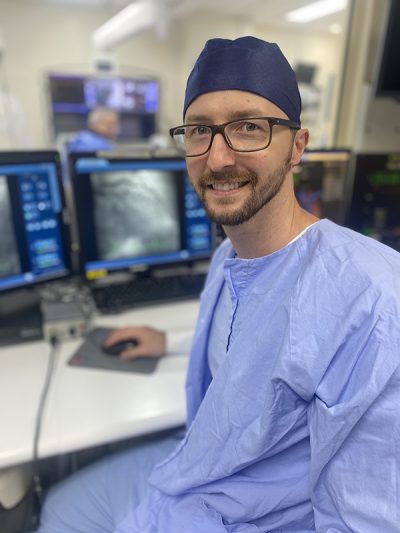Pre-hospital pathway improving heart attack outcomes
Clinicians at The Prince Charles Hospital (TPCH) have identified that reducing the time delay from diagnosis to in-hospital treatment can significantly improve a heart attack patient’s outcome and is associated with lower short and long-term mortality.
For people suffering a heart attack, accessing timely hospital treatment is crucial.
Clinicians at The Prince Charles Hospital (TPCH) have identified that reducing the time delay from diagnosis to in-hospital treatment can significantly improve a heart attack patient’s outcome and is associated with lower short and long-term mortality.

Michael Savage has been investigating how to improve outcomes for heart attack patients
Consultant Cardiac Scientist and researcher Michael Savage said that myocardial infarction is the most common and life threatening type of heart attack which occurs when plaque on the coronary vessel ruptures and blocks off blood supply to the heart muscle.
“Delays in unblocking these coronary vessels prevents vital blood supply to the heart muscle and can lead to unstable heart rhythms, heart failure or even death,” Michael said.
“We know that opening the blockage with balloons and stents performed in a hospital catheter lab within two hours from diagnosis, is the most effective method to re-establish blood supply to the heart and successfully preserve the heart muscle.”
For the last decade, and as a part of his PhD, Michael has undertaken various studies with the expert cardiology team at TPCH, the Queensland Ambulance Service and statewide interventional cardiology teams investigating how to achieve the optimal time in treating heart attack patients and ultimately improve their chance of survival.
His most recent study has focused on using a standardised statewide pre-hospital activation pathway which involves a structured orchestration of clinical steps and processes to streamline treatment.
The pathway, produced in collaboration with the QAS, involves the rapid identification of a heart attack patient by QAS in the field through a pre-activation checklist. QAS then contacts the interventional cardiologist on-call at one of the primary catheter labs while appropriate medical therapy is administered without delay.
On arrival at the hospital, patients are transferred directly to the catheter lab rather than the ED where they are assessed and treated by catheter lab staff who are already waiting for the patient. For afterhours cases, catheter lab staff are called in while the patient is enroute to the hospital so treatment can begin without delay on the patient’s arrival.
An evaluation of over 2,500 patients treated via the pathway across eight Queensland public catheter labs found that the time from diagnosis to completed treatment could be reduced by 50 minutes with opening of the blocked coronary vessel occurring within 34 minutes of hospital arrival.
“This significant reduction in treatment time has an immense impact on the health of patients. It can mean the difference between life and death,” Michael said.
Michael’s research has highlighted significant improvements in mortality rates in patients treated via the pre-activation pathway.
“Short term mortality (30 days) rates of patients on the pathway was 1.6% compared to 6.6% of patients on a non-pathway, with one year mortality rates being 2.9% on the pathway versus 9.5% on a non-pathway,” he said.
“Our research highlights the importance of having a dedicated pathway which allows heart attack patients to receive the best possible chance at survival, immediately and in the future.”
The pathway has been expanded to all Queensland public hospital sites with catheter laboratories and demonstrated that a standardised process can be successfully employed on a large scale.
